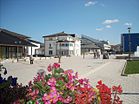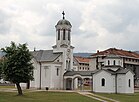Pale, Bosnia and Herzegovina
|
Pale Пале |
|||||
|---|---|---|---|---|---|
View of Pale
|
|||||
|
|||||
 Location of Pale, Bosnia and Herzegovina within Bosnia and Herzegovina |
|||||
| Coordinates: 43°49′0″N 18°34′10″E / 43.81667°N 18.56944°ECoordinates: 43°49′0″N 18°34′10″E / 43.81667°N 18.56944°E | |||||
| Country | Bosnia and Herzegovina | ||||
| Entity | Republika Srpska | ||||
| Government | |||||
| Area | |||||
| • Total | 492,8 km2 (1,903 sq mi) | ||||
| Population (2013 census) | |||||
| • Total | 22,282 | ||||
| • Density | 45,2/km2 (1,170/sq mi) | ||||
| Time zone | CET (UTC+1) | ||||
| • Summer (DST) | CEST (UTC+2) | ||||
| Area code(s) | 57 | ||||
Pale (Serbian Cyrillic: Пале) is a town and a municipality in Bosnia and Herzegovina, located southeast of Bosnia's capital Sarajevo. The municipality of Pale is one of the six municipalities of the City of Istočno Sarajevo located in the Republika Srpska entity of Bosnia and Herzegovina.
Pale always represented an important junction between east and west that is the Sarajevo Valley and the Drina River basin. There are preserved ruins of roads and building from the Roman times in the nearby villages of Miosici and Ilijak. From early on this area served as a place of trade. In the late 14th and early 15th century the area surrounding Pale belonged to the Feudal House of Pavlović. There were several fortified settlements: Pavlovac on the River Praca, Gradina in the Upper Pale and Hodidjed above the junction of the Miljacka rivers. The Hodidjed settlement served as an administrative center for the surrounding area.
The feudal house of Pavlović belonged to the upper crust of the Bosnian aristocracy, their holdings extended from Vrhbosna (today's Sarajevo) on the West to Dobruna on the east. Pavle Radenović, the founder of the Pavlović line, aside from his ancestral holdings around Pale also owned the mines in Olovo, the city of Trebinje, and parts of Konavle and Cavtat. The area under his control enjoyed prosperous trade between the locals and the Merchants from Dubrovnik. The main trading center was the town of Praca, part of the Pale Municipality today. After the death of Pavle in 1415 during a duel, his younger son Radoslav Pavlović (1420–1421) would take over from his father.
After the death of the Bosnian King Tvrtko I in 1391 the Bosnian feudals houses struggled to gain the throne. The sons of Pavle, under the threat from other Bosnian aristocrats, asked for the help of their allies the Ottomans. The Ottomans pursued a strategy of divide and conquer that eventually resulted in complete conquest.
...
Wikipedia




